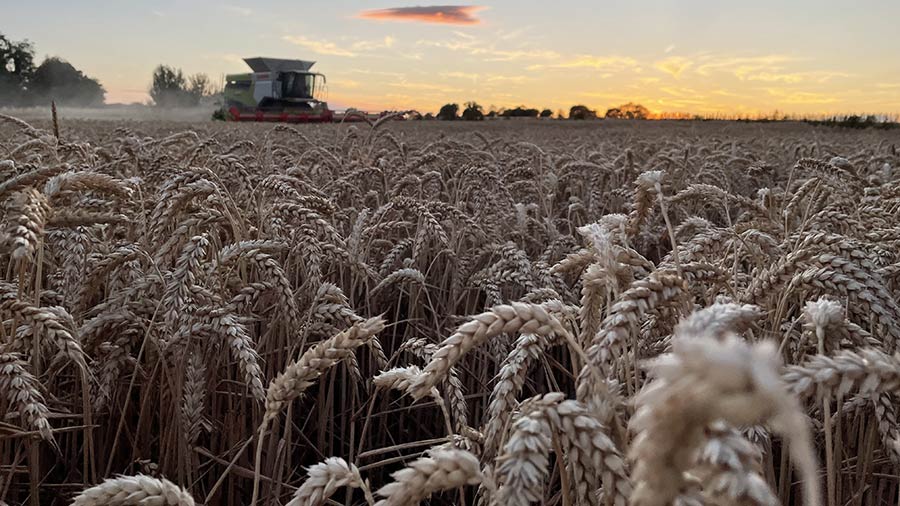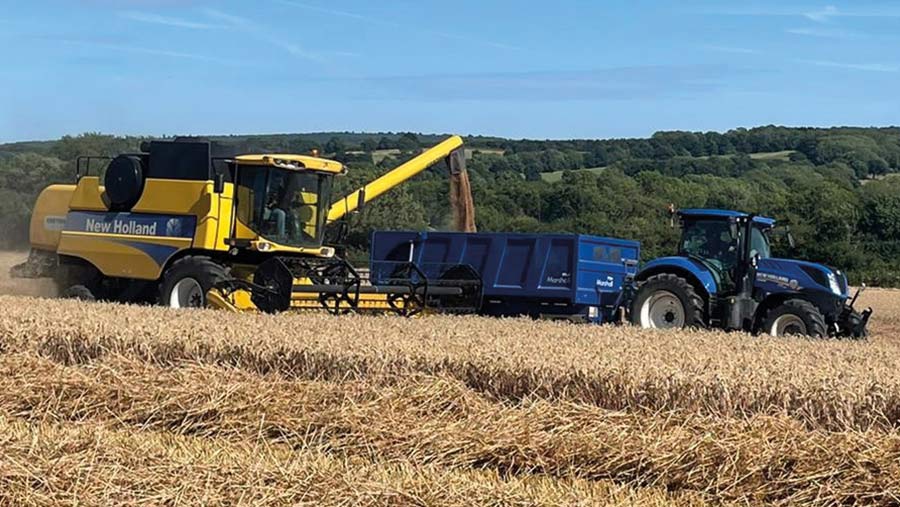Harvest 2022: Wheat holding up well despite month-early harvest
 Wheat harvest in Cambridgeshire - photo submitted to the Harvest 2022 gallery by Kate Hodgson
Wheat harvest in Cambridgeshire - photo submitted to the Harvest 2022 gallery by Kate Hodgson Winter wheat harvest has begun up to a month earlier for some growers and despite the warm, dry temperatures in those areas, yields and specific weight are doing well. We spoke to farmers around the country to find out how their harvests are faring.
See also: Harvest 2022: Disappointing yields for OSR and linseed
Peacock Farm, Leicestershire
Leicestershire grower Leigh Donger started combining winter wheat a month earlier than usual and expects to have completely finished harvest by the middle of August.
Growing the varieties Extase and Skyscraper with a small area of Insitor and Gleam, Extase was the standout cultivar, with a specific weight of 82kg/hl, while Skyscraper was behind at 76kg/hl.
Starting on the second wheats, yields came in at 8t/ha, followed by the first wheats at 9t/ha.
“We had one field of Extase which hit 10.5t/ha, but we never go for massively high yields as we try to minimise inputs and concentrate on margin.
“So far 120ha have been cut, with another 200ha of wheat to go. We’re expecting a slight loss of yield, but if we were to average 9.3-9.5t/ha we would be really happy with that.”
Usually cutting wheat around 15 August, Mr Donger notes that if the weather continues as it has been, harvest of all crops will be completed by the same date he would usually start wheat.
Yet to be cut is 40ha of spring barley, 160ha of winter beans and 40ha of spring oilseed rape which is pressed on farm and sold under the Peacock brand.
“Winter beans are usually ready on 24 August yet some fields look like they could be harvested today, which is absolutely bonkers. With all crops turning so fast we won’t be harvesting the beans until the first week of August,” he says.
Titsey Estate, Surrey
The Titsey Estate in Surrey kick-started winter wheat harvest at the start of the week, cutting into a crop of Zyatt at 14% moisture.
With initial yields coming in at 10t/ha, farm manager Bill Peters, who has managed the farm for 36 years, says harvest is going well.

Titsey Estate Zyatt crop © Pitchfont Farm
“We’ve made a good start to the wheat. Despite the lack of rain, it’s a lovely colour, is thrashing well and we hope it will make milling quality,” says Mr Peters.
Quality of Zyatt, the one variety grown at the estate located just inside the M25 in east Surrey, was good, with a specific weight of 82.1kg/hl and protein of 13.2%.
Although harvest has begun a few weeks earlier than usual, Mr Peters notes that this isn’t unheard of as harvest has begun during this time in July before.
“But like many other farmers we are in desperate need of some rain. The last time we had a decent amount was 5mm two weeks ago,” he says.
Chapel Bridge Farm, Cambridgeshire
Less than 180mm of rain has fallen at Chapel Bridge Farm this year and with no rain since the beginning of June crops suddenly burnt off, going from green and lush to burnt and brown in a matter of days.
Winter wheat harvest therefore began two weeks earlier, with variable yields.
Starting with a field notorious for its low performance, farm worker Matt Styles explains yields came in at 5t/ha, but the main crop of Gravity performed well at 9t/ha and 13% moisture.

Matt Styles © Tim Shreiver
“We experienced two weeks of warm, dry, sunny weather with temperatures consistently above 25C and then a heatwave which peaked at 40.5C.
“Where fields would usually gradually ripen, this weather suddenly burnt crops off and meant we started harvest a good two weeks earlier than usual. Although this isn’t normal, harvesting in July is not unheard of as 2018 was a similar year.
“This is in stark contrast to last year where we had 50% of crops still to be harvest at the beginning of September as the result of two wet weeks in August where we couldn’t cut a thing,” he says.
Mr Styles also notes that spring peas yielded disappointingly as a result of the dry conditions, which stressed crops.
“With the dry weather, we think the peas just gave up. Where we would usually expect five peas per pod we only had two.”
Although yields are lower, the earlier harvest will enable an earlier August drill date for OSR to get crops established so they can better withstand cabbage stem flea beetle attacks.

